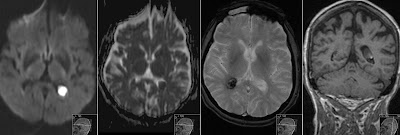CT Radiation Dose Report
This is a standard radiation dose report generated by GE LightSpeed 64-slice CT scanner. This is a report of the CT Angiography including native CT Brain scan followed by CT Angiography of the Head and Neck. Values presented in this report are: CTDI - CT Dose Index and DLP - Dose Length Product. Some physics:
The CTDI represents the radiation dose of a single CT slice and is determined using acrylic phantoms. The weighted CTDI (CTDIw) reflects the weighted sum of two thirds peripheral dose and one third central dose in a 100-mm range in acrylic phantoms. The volume CTDI (CTDIvol), defined as CTDIw divided by the beam pitch factor, is the most commonly cited index for modern MDCT equipment. The dose length product (DLP) is the CTDIvol multiplied by the scan length (slice thickness × number of slices) in centimeters.
DLP is independent of what is being scanned. So it is the same for a little child as for a large adult. It is possible, but difficult, to estimate the effective dose equivalent using some conversion factors. If we would like to determine a more accurate effective dose equivalent then individual organ doses would have to be determined. The effective dose equivalent is the sum of the product of organ doses (in mGy or cGy, the magnitude of CT organ doses) multiplied by a corresponding weighting factor. The effective dose represents a total body dose. For regional exposures, the effective dose equivalent is the equivalent dose to the whole body, for example, approximately 2.0 to 3.0 mSv for a head CT.
So the DLP method of estimating dose offers only approximation of the radiation that patient receives.
My conclusion from above is: Include the report in your evaluation and check for the Total Exam DLP. Be aware of the radiation expose values for specific exams. I wish in the future such values would be included as standard information on CT reports.
The CTDI represents the radiation dose of a single CT slice and is determined using acrylic phantoms. The weighted CTDI (CTDIw) reflects the weighted sum of two thirds peripheral dose and one third central dose in a 100-mm range in acrylic phantoms. The volume CTDI (CTDIvol), defined as CTDIw divided by the beam pitch factor, is the most commonly cited index for modern MDCT equipment. The dose length product (DLP) is the CTDIvol multiplied by the scan length (slice thickness × number of slices) in centimeters.
DLP is independent of what is being scanned. So it is the same for a little child as for a large adult. It is possible, but difficult, to estimate the effective dose equivalent using some conversion factors. If we would like to determine a more accurate effective dose equivalent then individual organ doses would have to be determined. The effective dose equivalent is the sum of the product of organ doses (in mGy or cGy, the magnitude of CT organ doses) multiplied by a corresponding weighting factor. The effective dose represents a total body dose. For regional exposures, the effective dose equivalent is the equivalent dose to the whole body, for example, approximately 2.0 to 3.0 mSv for a head CT.
So the DLP method of estimating dose offers only approximation of the radiation that patient receives.
My conclusion from above is: Include the report in your evaluation and check for the Total Exam DLP. Be aware of the radiation expose values for specific exams. I wish in the future such values would be included as standard information on CT reports.



